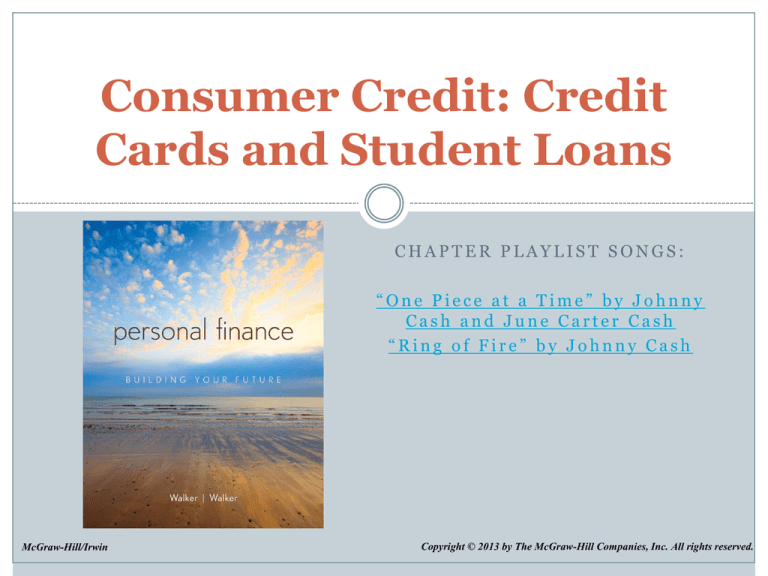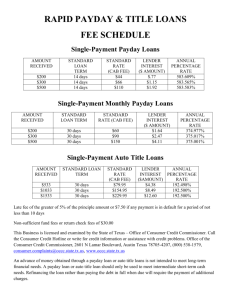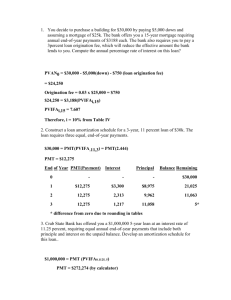
Consumer Credit: Credit
Cards and Student Loans
CHAPTER PLAYLIST SONGS:
“One Piece at a Time” by Johnny
Cash and June Carter Cash
“Ring of Fire” by Johnny Cash
McGraw-Hill/Irwin
Copyright © 2013 by The McGraw-Hill Companies, Inc. All rights reserved.
Learning Objectives
• LO 5-1 Explain the responsibilities, importance,
•
•
•
and cost of credit as well as the options
available for accessing credit.
LO 5-2 Evaluate the features, benefits, and
disadvantages of many different types of
credit cards.
LO 5-3 Describe the mechanics of obtaining and
repaying student loans.
LO 5-4 Assess the benefits and drawbacks of
payday loans, title loans, and rent-to-own
credit options and identify alternatives.
5-2
Credit
A contractual agreement in which a borrower
receives something of value now and agrees to repay
the lender at some date in the future, generally with
interest
Family and Friends
General Purpose Credit Card
Secured
Unsecured
Store Credit Cards
Depository Institutions
Finance Companies
5-3
Friends and Family
Advantages
Friendly money
No credit application
No credit check
Low/no interest rate
Common Uses
First car
Down payment on first
home
Money when needed
quickly
Disadvantages
Can ruin family
relationships through
jealousy and nonpayment
Can cause financial hardship
on the lender
Does not build credit record
Advice
Have everything in writing
Treat it as one of your most
important payments
Refinance with a traditional
lender as soon as possible
5-4
General Purpose Credit Cards
(i.e., Visa, Discover, MasterCard, American Express)
Advantages
Widely accepted
Builds credit record
Buyer protection
Recordkeeping
Miles or cash back
Common Uses
Household items
Auto repair
Auto rental
Airline and hotel
reservations
Online purchases
Disadvantages
High interest rate
Fees and charges
Easy to overspend
Once in credit card debt it is
hard to get out of debt
Advice
Only use credit card for
emergencies
Always repay the full
balance
Pay on time every time
5-5
General Purpose Credit Cards
Secured Credit Cards
Require a deposit to be
held by the credit card
company
Credit limit is the
amount on deposit
Good for starting a credit
file or rebuilding a credit
file after bankruptcy
Unsecured Credit Cards
No deposit required
Credit limit and interest
rate depends on your
income, credit score
No collateral required
5-6
Store Credit Cards
(i.e., Sears, Best Buy, BP, Home Depot, Macy’s)
Advantages
Special Promotion
Recordkeeping
Builds credit record
Buyer protection
Common Uses
Household items
Home repair
Auto repair and fuel
Disadvantages
Only accepted at specific store
High interest rate
Fees and Charges
Easy to overspend
Once in credit card debt, it is
hard to get out of debt
Advice
Always repay the full balance
Pay on time every time
5-7
Depository Institutions
Advantages
Builds relationship with local
lender
Builds credit record
Generally lower interest rates
Oldest form of credit
Common Uses
Automobile
Home improvement
Major purchases
Disadvantages
Higher credit standards
and harder to get the loan
Loans hard to get if under
$1,000
Advice
Build a relationship with
your banker so he/she
knows you
Only take out a loan if you
really need it
5-8
Finance Companies
Advantages
Ease of credit
Some specialize in
specific areas
Will finance lower loan
amounts
Common Uses
Automobile
Home furniture
Major appliances
Disadvantages
Higher interest rates
Fees and charges
Advice
Shop for your best rate and
terms
Only take out a loan if you
really need it
5-9
Characteristics of the Differing Credit Options
5-10
Revolving Line of Credit
Revolving Lines of Credit: You pay a commitment fee and can take and repay
funds at will
Credit Limit: $1,000
Charge: - $300
Balance: $700
How much more you can borrow: $700, Owe: $300
Previous Balance: $700
Payment: $200
Balance: $900
How much more you can borrow: $900, Owe: $100
Previous Balance: $900
Payment: $100
Balance: $1,000
How much more you can borrow: $1,000, Owe $0
5-11
Applying for Credit
Sections of the credit application
Demographics
Income
Assets and liabilities
Contacts
Attest and authorization
5-12
Five Cs of the Credit Decision
Character
Responsibility in repaying loan
Capacity
Enough income minus expenses to pay loan
Collateral
Something of value to secure the loan
Capital
Net worth, other assets that could be sold to pay the loan
Conditions
Economic conditions for specific industries
5-13
Risk and Interest Rates
The higher the risk of not being repaid, the higher
the interest rate charged to offset the risk
Risk determined by your 5 Cs of credit and credit
score
If you have high income, your risk decreases
If you have collateral, your risk decreases because
the lender can sell collateral
If you have a lot of capital (high net worth), your
risk decreases and rates are lower
5-14
Credit Cards
First credit card was in 1950s with Diners Club
1957: American Express and BankAmericard (now
Visa) enter market
In 2010…
Average household credit card debt > $10,000
Average undergraduate credit card debt > $3,000
Average college senior credit card debit > $4,000
5-15
Advantages of Credit Cards
Arbitration
Interest-free loans
Automatic bill
Purchase
payments
Identity theft
safeguards
Credit builder
Extended
warranties
protection
Rental car coverage
Rewards
5-16
Features of Credit Cards
Credit limit – The amount you can borrow without
penalties and fees for over-the-limit transactions
Grace period – The time you have to pay your bill
before finance charges are activated. Not all credit
cards have a grace period
Interest rate – The charge you have for borrowing
money
Can be fixed or variable based on an index rate
Can be very high for some credit cards
5-17
Credit Card Charges and Fees
Finance Charges
Adjusted balance method – Payments or credits received
during the current billing period are subtracted from the
balance at the end of the previous billing period.
Average daily balance method – Most common method.
Every day your balance reflects any charges and/or payments.
Minimum finance charge – The minimum interest that is
charged per billing cycle.
5-18
Doing the Math 5.2
5-19
Fees
Annual - Charge for the privilege of having the card
Cash Advance
A flat fee for the advance
A percentage fee for the amount of money taken
Late-Payment – A penalty fee charged for paying late
Over-Limit – A penalty fee for charging over your credit
limit
Return-Item – A penalty fee for a bounced check
Balance Transfer – A percentage fee for transferring
balance from one card to another
5-20
Errors on Your Statement
According to the Fair Credit Billing Act:
Contact credit card company in writing within 60
days after statement date on the bill with the error
Send letter to “billing inquiries” address on
statement
5-21
Errors on Your Statement, ctd.
Include your name/account number and state the
error, why it is an error, and the date of the error–
and include copies of any supporting documents
Keep a copy; the credit card company will investigate
the complaint and if the charge is found to be in
error, you will not have to pay any interest on the
disputed amount
5-22
Household Use of Credit/Economy Impact
Credit Picture Different for Rich, Poor Households
http://www.npr.org/player/v2/mediaPlayer.html?action=1&t=1&islist=false&i
d=90112615&m=90127338
5-23
Choosing a Credit Card
CC1:
Credit Card Features
Priority
Rank
Rank
CC1 Score
(Priority
Rank*CC1
Rank)*
CC2:
Rank
CC2 Score
(Priority
Rank*CC2
Rank)*
CC3:
Rank
CC3 Score
(Priority
Rank*CC3
Rank)*
APR: purchases
APR: cash advances
APR : balance transfers
APR if you pay late
Interest Rate: fixed, variable or tiered
Grace Period: balance paid off
Grace Period: carry a balance
Grace Period for cash advances
Finance charge calculation: 1 or 2 cycles
Finance charge include/exclude new purchases
Ave or Adjusted finance charge calculation:
Minimum finance charge
Fee: annual
Fee: late payment
Fee: over credit limit
Fee: set-up
Cash Advance: Transaction fee
5-24
Tips for keeping credit card rates and fees low
Select a card based on how you plan to use it
Pay on time
Don’t charge over your credit limit
Maintain balance < 30% of your credit limit
Look out for new fees
Be judicious about all your personal finance activity
Complain if your rates or fees increase
5-25
Student Loan Categories
Federal student loans made directly to the student
Federal student loans made to the parents (PLUS)
Private student loans made to students or parents
Application: Free Application for Federal Student Aid
(FAFSA) www.fafsa.ed.gov.
5-26
Subsidized vs. Unsubsidized Federal Student Loans
Comparison Table
5-27
Student Loan Payments
Student Loan Consolidation and Refinancing
One rate for all your student loans
One lender
Deferment
Delays the repayment of the loan
No interest is accrued for subsidized loans
Forbearance
Can postpone or reduce payments for a specific period of time
Interest continues to accrue
Alternate Payment Options
5-28
Student Loan Payments
Standard Repayment
10 year repayment
$50 minimum payment
Extended Repayment
Not to exceed 25 year repayment
Minimum loan amount of $30,000
Graduated Repayment
Start out low and increase every two years
Up to 10 year repayment
Income-Based Repayment (IBR)
Based on income and family size
Monthly payment less than 10-year standard repayment
Must submit annual documentation to set payment
5-29
Calculating Payments
PVA = PMT ({1 – [1/(1 + i)n]}/i) where
PVA = Present Value of an Ordinary Annuity
PMT = Payment
i = Interest Rate per Period
n = Number of periods
Example: Financing $1,000 at 12% interest annually (or 1%
monthly) for 1 year making monthly payments:
PVA = $1,000
i = .01
n = 12
5-30
Calculating Payments Formula Example
$1,000 = PMT ({1 – [1/(1 + .01)12]}/.01)
$1,000 = PMT {[1 – (1/1.0112)]/.01}
$1,000 = PMT {[1 – (1/ 1.126825)]/.01}
$1,000 = PMT (1 - 0.887449)/.01
$1,000 = PMT (0.112551/.01)
$1,000 = PMT (11.25508)
Next solve for PMT by dividing both sides by 11.25508
$1,000/11.25508= PMT (11.25508)/11.25508
PMT = $88.85
5-31
Example: Amortization Table $1,000, 1 year, at 12% APR
5-32
Costly Cash
Payday Loans
Title Loans
Rent-to-Own
Usury Law: State laws that specify the maximum legal
interest rate at which loans can be made
Predatory Lending: Act of lending money at an
unreasonably high interest rate, making repayment
excessively difficult or impossible for the borrower
5-33
Payday Lenders
Short-term loans
Write the payday lender a check for the amount you
want to borrow plus a fee
If you don’t pay off the loan on the specific date,
there is a roll-over fee
Annual percentage rate, including the fees, can be
250% or higher
5-34
Title Loans
Title of an automobile is collateral for the loan
Typically for no more than 25% of the value of the
automobile
Short-term loan
Could lose your vehicle if you don’t repay the loan
High interest rate
5-35
Rent-to-Own
Make purchases with low weekly payments
Effective interest rates very high
5-36
Alternatives to Payday Loans
5-37







